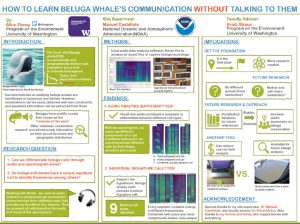How To Learn Beluga Whales Communication Without Talking To Them
Cook Inlet belugas (CIB) are critically endangered and still shows no signs of recovery since full protection decades ago. More understanding of this group of animals is needed in order to better protect and conserve their species. Whale vocalization has proved to be extremely informative on whale’s social structure and geographic distribution. Therefore, learning about beluga vocalization may be the first step in understanding the fundamentals of this species. The purpose of this study is first, to try to learn more about beluga vocalization through analyzing their recorded calls in order to infer their geographic distribution and population structure. Secondly, to explore audio analysis programs on existing audio data and determine its efficiency in studying vocalizations. For my internship with NOAA, I Analyzed collected audio data from captive beluga whales using the audio analysis program, Raven. I was able to categorize several distinctive call types using only the spectrogram and audio and was able to relate each call to a possible owner. It is reasonable to think that each beluga has its own distinctive signature call through all the data analyzed and the method using audio analysis has proved to be efficient and adequate in study beluga vocalization. From this research, we can confirm that more audio analysis can be used for future vocalization studies when the subject is less accessible in the wild. It can also be a more convenient and less expensive way to test hypotheses than other methodologies.
